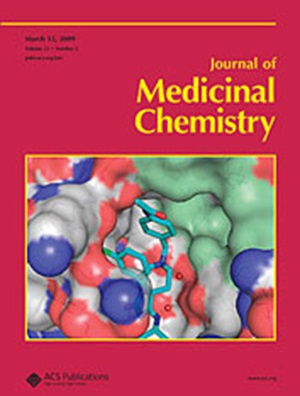基于肽的新型PET探针在乳腺癌中HER2无创成像的芯片设计与评价
IF 6.8
1区 医学
Q1 CHEMISTRY, MEDICINAL
引用次数: 0
摘要
HER2的过表达与乳腺癌的发病和进展密切相关。开发HER2靶向PET示踪剂用于无创评估HER2表达,对于筛选适合HER2靶向治疗的患者、评估治疗效果和优化治疗具有重要的临床意义。在本研究中,我们采用计算模拟的方法开发了曲妥珠单抗衍生肽WC8,并设计了靶向HER2的放射性示踪剂[68Ga]Ga-DOTA-WC8用于检测HER2的表达。该放射性示踪剂具有纳米摩尔亲和力、高特异性和良好的药代动力学。PET显像显示[68Ga]Ga-DOTA-WC8在HER2阳性乳腺癌组织中表现出明显的特异性摄取,有助于快速准确地鉴定HER2的表达。值得注意的是,该放射性示踪剂被成功地用于直接可视化肿瘤对HER2酪氨酸激酶抑制剂pyrotinib的反应。这些发现表明,基于肽的放射性示踪剂[68Ga]Ga-DOTA-WC8是一种很有前景的工具,可以准确监测HER2靶向药物治疗后的HER2表达。本文章由计算机程序翻译,如有差异,请以英文原文为准。

In Silico Design and Evaluation of Novel Peptide-Based PET Probe for Noninvasive Imaging of HER2 Expression in Breast Cancer
The overexpression of HER2 has been strongly correlated with the pathogenesis and progression of breast cancer. Developing HER2-targeted PET tracers for noninvasive assessment of HER2 expression holds substantial clinical significance for screening patients suitable for HER2-targeted therapy, evaluating treatment efforts, and optimizing treatment. In this study, we employed computational simulation methods to develop peptide WC8 derived from trastuzumab, and designed HER2 targeting radiotracers [68Ga]Ga-DOTA-WC8 for detecting the HER2 expression. The radiotracer demonstrated nanomolar affinity, high specificity, and favorable pharmacokinetics. PET imaging revealed that [68Ga]Ga-DOTA-WC8 exhibited significant and specific uptake in HER2-positive breast cancer tissues, facilitating the rapid and accurate identification of HER2 expression. Notably, this radiotracer was successfully utilized to achieve direct visualization of tumor response to pyrotinib, a HER2 tyrosine kinase inhibitor. These findings suggest that the peptide-based radiotracer [68Ga]Ga-DOTA-WC8 represents a promising tool for accurately monitoring of HER2 expression after treatment with HER2-targeting drugs.
求助全文
通过发布文献求助,成功后即可免费获取论文全文。
去求助
来源期刊

Journal of Medicinal Chemistry
医学-医药化学
CiteScore
4.00
自引率
11.00%
发文量
804
审稿时长
1.9 months
期刊介绍:
The Journal of Medicinal Chemistry is a prestigious biweekly peer-reviewed publication that focuses on the multifaceted field of medicinal chemistry. Since its inception in 1959 as the Journal of Medicinal and Pharmaceutical Chemistry, it has evolved to become a cornerstone in the dissemination of research findings related to the design, synthesis, and development of therapeutic agents.
The Journal of Medicinal Chemistry is recognized for its significant impact in the scientific community, as evidenced by its 2022 impact factor of 7.3. This metric reflects the journal's influence and the importance of its content in shaping the future of drug discovery and development. The journal serves as a vital resource for chemists, pharmacologists, and other researchers interested in the molecular mechanisms of drug action and the optimization of therapeutic compounds.
 求助内容:
求助内容: 应助结果提醒方式:
应助结果提醒方式:


